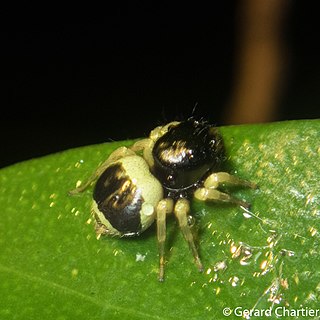
Attulus is a genus of jumping spiders that was first described by Eugène Louis Simon in 1889. The name is a diminutive form of a common prefix for salticid genera, -attus.

Phlegra is a genus of jumping spiders that was first described by Eugène Louis Simon in 1876. The name is a reference to a mythical location in both Greek and Roman mythology.

Plexippus is a genus of jumping spiders that was first described by Carl Ludwig Koch in 1846. It is considered a senior synonym of Hissarinus and Apamamia.
Proszynskiana is a genus of Asian jumping spiders that was first described by D. V. Logunov in 1996. It is named in honor of arachnologist Jerzy Prószyński.

Pystira is a genus of spiders in the jumping spider family Salticidae.

Stenaelurillus is a genus of jumping spiders that was first described by Eugène Louis Simon in 1886. Most species live in Africa, with some species found in Asia, including China. All species have two white longitudinal stripes on the carapace, and both sexes show strong bristles around the eyes. The name is a combination of the Greek sten- "narrow" and the salticid genus Aelurillus.

Zygoballus is a genus of jumping spiders found in North and South America.

The Dendryphantina are a subtribe of jumping spiders that occur mainly in the New World. The subtribe was first defined by Anton Menge in 1879 as Dendryphantidae. Females of the subtribe generally show paired spots on the abdomen, and the males often have enlarged chelicerae. Females in this subtribe typically have S-shaped epigynal openings.

Lyssomaninae is a subfamily of jumping spiders. It includes four genera, three from the New World.

Euophryini is a tribe of jumping spiders. It has also been treated as the subfamily Euophryinae.

The Plexippini are a tribe of jumping spiders (Salticidae). They have also been treated as the subfamily Plexippinae. They are native to the Old World.

Wanda Wesołowska is a Polish zoologist known for her work with arachnids. Her research focuses on the taxonomy, biology and zoogeography of jumping spiders.
Marusyllus is a genus of spiders in the family Salticidae, found in Russia, Central Asia, the Indian subcontinent and China.
Ansienulina is a genus of spiders in the jumping spider family Salticidae. It was first described in 2015 by Wanda Wesołowska. As of 2017, it contains only one species, Ansienulina mirabilis, found in Kenya, Angola, and Namibia.
Ragatinus is a genus of spiders in the family Salticidae. It was first described in 2016 by Angelika Dawidowicz and Wanda Wesołowska. As of 2017, it contains only one species, Ragatinus maddisoni.

Pseudomogrus is a genus of jumping spiders first described by Eugène Simon in 1937.
Kakameganula is a genus of East African jumping spiders with the sole species Kakameganula holmi. It was first described by Angelika Dawidowicz & Wanda Wesołowska in 2016, and has only been found in Kenya.

The Sitticini are a tribe of spiders in the family Salticidae. The tribe has been divided into two subtribes, Aillutticina, with five Neotropical genera, and Sitticina, with five genera from Eurasia and the Americas. One genus is unplaced within the tribe. The taxonomy of the tribe has been subject to considerable uncertainty. It was clarified in 2020.
Manzuma is a genus of spiders in the jumping spider family Salticidae native to Africa.












